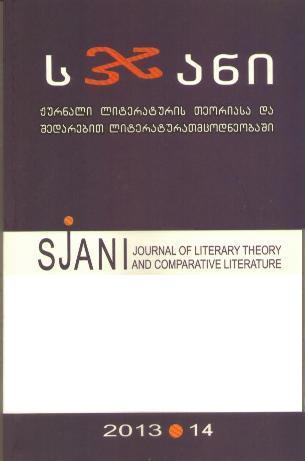აგიოგრაფიის კულტურული კონტექსტი
Culturological Context of Hagiography
Author(s): Ivane AmirkhanashviliSubject(s): Literary Texts
Published by: ლიტერატურის ინსტიტუტის გამომცემლობა
Keywords: hagiography; cultural process; genre development.
Summary/Abstract: Culturological Context of Hagiography Summary Key words: hagiography, cultural process, genre development. Georgian Christian culture is traditionalistic. It is true that culture as a “conscious goal” has been established since the fourth century after the conversion of Kartli but traditionalism is also preserved on the stage of transition from paganism to Christianity. The old cults of the Sun, grape, St.George are carried into a new religion. The evidence to the continuity of pre-Christian cultural tradition is the fact that the Robe of the Lord brought from Jerusalem by Elioz of Mtskheta and Longinoz of Karsani, becomes protector of Georgian nation. This sacred thing is a protector of Georgians and also a symbol of national integrity. That is why the seamless Robe of the Lord was displayed on Georgia’s royal coat of arms and the main, central part of the royal coat of arms was given to this relic. The creation of Georgian cultural pattern starts as a result of the relationship between cosmopolitan Christian faith and local autochthonous brain. The understanding of the dynamics of cultural variability depends on comprehension of the process which is termed diffusion by culture experts. Diffusion is a transition of constituent parts or characteristic features of one culture to another culture. The mastering of elements and features occurs according to the principle of opening, mixing, “blending”, although some components of culture might less subordinate this principle. No less important is the individual factor. As is known, significant role in shaping the culture is assigned to personality. If we put it in the language of philosophical anthropology, a man gives birth to culture and culture gives birth to a man. Cultural process is explained by means of a person, an individual is a driving force for culture and also responsible for the events happening in culture. Culture as a historical fact is read in personality. Personalities create a tradition that is nothing more than historicity of a culture. St.Nino, King Mirian, Vakhtang Gorgasali, Iakob Tsurtaveli, Assyrian Fathers, Abo Tbileli, Ioane Sabanisdze, etc. Individual biographies of these personalities have laid the foundation of Georgian Christian culture. The birth of hagiography meant the birth of tradition. Culture received natural status - it became hereditary. Cultural situation activated language structure and the formation of literature started. Hagiographic text is an eternal present which flows when we touch, read or listen to it. With the help of comprehension and imagination the process of recreation and reexperience is realized. The style of hagiography is a socio-cultural phenomenon, the handwriting of the time and the environment it stemmed from. A description of the saint’s life is a cultural pattern with its conceptual content.
Journal: სჯანი
- Issue Year: 2013
- Issue No: 14
- Page Range: 8-13
- Page Count: 6
- Language: Georgian

